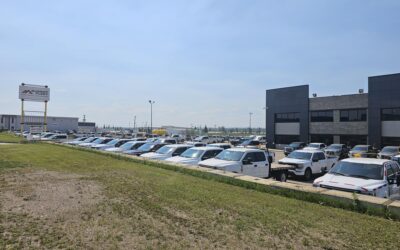How to Manage High Risk Fleet Drivers
The majority of the fleet accidents are a result of risky driving by only a handful of drivers. Because of these high-risk fleet drivers, the annual rate of commercial fleet accidents has reached 20%, and an average fleet accident costs around $70,000, which is twice the cost of a typical workplace injury.
To reduce the number of fleet collisions and ensure that the drivers are safe, it is extremely important to identify the high-risk fleet drivers and alter their negative driving behaviors using effective techniques.
Taking the following steps suggested by Advanced Driving Training Services, Inc. will help fleet managers and owners address the issue:
Identify High-Risk Drivers
Before you can deal with high-risk drivers, they will need to be identified. Fleet managers should take the time to check accident histories involving all motor vehicles for every driver in the fleet. This should bring to light the group of drivers who have been involved in a high number of crashes and violations.
Classify the Group
Once you’ve identified the risky drivers, divide them into four groups. Group 1 will include drivers with 1 to 2 violations; group 2 will include those with 3 to 4 violations, and group 3 will include all drivers who’ve been involved in more than 4 violations.
Train the Drivers
The fleet safety policy stresses on thorough and consistent training for high-risk drivers. Three effective processes that can be used for training include:
- Online Training: This includes online videos or modules that are suitable for group 1 drivers. The content is based on the specific area that drivers are facing problems with, such as overspeeding, backing accidents, following distance, etc.
- Face-to-face Training: This training is appropriate for group 2 drivers. It involves a full-day classroom and behind-the-wheel training that aims to enhance driving skills for safety. The program focuses on ideas such as responsibility, crash prevention, skill-building exercises, and scanning techniques.
- One-on-one Training: This training is most effective for group 3 drivers who have the highest degree of risk. Instead of being held in a hypothetical environment, one-on-one training is given to drivers on normal business days when they are on their normal route. This technique monitors their driving while on the road, and therefore, directly affects these drivers’ behaviors as they are more cautious. Besides improving safety, this type of training also helps to make them more productive.
Involve Managers
According to ADTS, fleet managers should actively be involved in solving the issues of high-risk fleet drivers. Since they’re the major point of contact with the drivers, they can play a role in reducing accident rates by promoting driver safety. Senior managers can provide manager workshop coaching to all managers, who can, in turn, conduct in-person training with drivers. This way, newly promoted managers will be educated on the best practices in promoting driver safety.
One of the great strategies that fleet managers can adopt is asking drivers for suggestions and ideas on how to bring down the fleet crash rates. Drivers are most aware of the causes of collisions, so they are more likely to come up with effective techniques. Involving drivers also means that they get equally concerned about safety, encouraging them to put in more effort. Also, it can help increase the motivation levels of drivers.
Consistently Maintain the Safety Culture
With so many training programs and techniques in the fleet safety policy, the effectiveness of the programs can be easily compromised. To prevent this, it is extremely important to keep the message alive and consistently maintain the culture of safety. Fleet managers should make it a point to regularly communicate the importance of driver safety and the associated standards to ensure it.
Besides sending newsletters from time to time, companies should also be consistent with training programs; for instance, by holding them on a quarterly basis. The reason why consistency is important is that it’s only after you regularly reinforce ideas like cell phone use, distracted driving, and other common problems, that people start taking them seriously.
Adding an evolutionary aspect to consistency is equally important, though. What was once considered a safety practice should be banned for fleet drivers today. For instance, not using a cell phone was once a safety practice and is now totally banned.
Also, companies will identify gaps and shortcomings as they consistently promote their drivers’ safety. Hence, companies need to keep reviewing their safety policies and update them. Depending on the outcomes and results, certain policies may be made more stringent, and several others that don’t seem to be working may be relaxed.
Focusing on training programs and keeping the safety concern alive without evaluating the outcomes is less likely to be effective. Hence, ensuring consistency also requires regular analysis of motor vehicle records for each driver, at least once a year. Offering incentives to drivers who seem to have improved their behavior will not only motivate them to improve further but will also encourage other high-risk drivers to be more cautious while driving.
Final Thoughts
To sum up, fleet accidents are an ongoing problem for fleet management companies. These accidents not only cost enormous amounts of money but also undermine the safety of the drivers behind the wheel. Based on the motor vehicle collisions records, only a small group of high-risk fleet drivers cause the majority of reported accidents.
Implementing sound and effective policies with carefully planned processes and strategies are important to ensure a driver’s safety. However, preparing a robust safety plan isn’t that simple. Companies and managers need to spend a considerable amount of time planning and crafting the details for a solid policy.
It’s not only the training programs that need to be effective and focus on individual driver issues; the fleet managers should also be actively involved in promoting the concern for safety. Once the policies are in place, all they need to do is maintain consistency and keep improving on them to ensure that fleet accidents are kept at a minimum and that driver safety is not compromised.
Source:
https://www.automotive-fleet.com/340207/how-to-deal-with-high-risk-drivers






